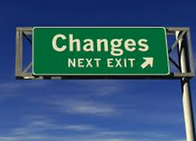This is a guest post from Sinead Mac Manus from digital wellbeing company 8fold and Integration Training social media trainer.
Change is tough
We’re well into February and I wonder how you’re getting on with your New Year’s resolutions. Perhaps the great plans to exercise more, eat better, work less have all faded into another busy year. Perhaps you set yourself some Big Hairy Audacious Goals for 2012 but they are now just another line on an increasing to-do list.
Old habits die hard. As humans we are programmed to take the path of least resistance which means we get stuck in our old habits whether they are still serving us or not. Breaking these habits and implementing new ones is difficult but it is one of the best ways of creating real behavioural change in our lives, whether that’s in our working practices or how well we look after our bodies. Once a habit is embedded it becomes second nature, witness brushing your teeth every morning, so we can use this ‘stickiness’ to our advantage when taking on good habits. As Aristotle says, “We are what we repeatedly do. Excellence, then, is not an act, but a habit”.
Leo Babauta from Zen Habits, one of the most read personal development blogs in the world, is one of the world’s leading experts on habits and behaviours. He has made a living out of changing his life one habit at a time from being overweight, unhealthy and in debt to living a vegan, minimalist lifestyle and blogging and writing about it. Oh, and he has six kids!
The problem with habits is that we frame them in the light of stopping negative behaviour and being disciplined about adding positive habits. Change framed in this way is unattractive to our lizard brain, it all sounds like too much work. It’s easier to stay the way we are.
The answer lies in re-framing habits as rituals
A ritual, once initiated, is easy to continue. You may have a morning ritual which involves waking to the alarm, jumping into the shower, getting dressed and then heading out the door to work. If we had to remember how to do all these activities each morning we would be exhausted before we have even started the day. Rituals codify our behaviour and provide useful short cuts, freeing up our pre-frontal cortex for more important issues.
So how do we introduce new rituals into our working day? Leo has a great article on 29 ways to successfully ingrain a behaviour but here are my ideas on how to make successful rituals:
1. Start small
Don’t try to make more than one new ritual at a time. Start with one, do it continually for a number of days and it will start to embed.
2. Use the power of when and where
If a new ritual for you is to write a blog post three times a week, then plan this into your schedule. If you want to start going to yoga twice a week then make the appointment in your calendar. Research shows that saying when and where you will complete a task increases the likelihood of you doing it.
3. Start today
Often with new habits or changes, we wait until the time is ‘right’. Monday morning or the start of a new month seems like a good time to start. Wrong. This is putting too much pressure on you. Just start now. There is a famous Kundalini yoga saying, “Start and the pressure will be off” that Bridget and I write about in our new book The Business Yogi. Like in work, sometimes we do anything not to get on the mat. But when we eventually drag ourselves onto the mat, the pressure’s off and the practice flows. It’s starting, and worse, thinking about starting, that’s the problem. So less thinking and more doing is the way to go.
4. Use the power of association
At work we can spend a lot of our time on autopilot, jumping from one task to the next without thinking about why we are working the way we are working. An easy example of this is making a cup of coffee in the morning and sitting at your computer to read your emails. Why not use our autopilot tendencies to change the ritual? My morning ritual involves the coffee but instead of getting caught up in my email, I spend a few quiet minutes planning my day before getting on with my Most Important Task for the day. Another ritual involves a tea break and Twitter. Identify rituals that you already perform and change the pattern of behaviour.
5. Let the urge pass
Our homeostatic nature will try and drag us back to our old habits and rituals. But by being aware of this, we can start to open up the gap between urge and action. Next, time you feel the urge to open your email inbox when you should be working, feel the urge come, say hello to it, and then let it go. Breathe, and get back to your work.
—-
Sinead Mac Manus is founder of 8fold, a digital wellbeing company that helps busy people work better. Sinead has just launched Mindful Productivity – a six week eClass full of practical, get-going insights and tactics so that you’ll have an action plan to do more Right Work and make an impact with your business. Find out more here. The Business Yogi book by Sinead and Bridget Stacey-Luff will be published in April 2012.
Abbie Allen
I enjoyed your post (via @walshmark). The concept of rituals instead of habits really resonated with me. I especially like the idea of taking existing rituals and adjusting them. I can see this as being quite doable for me, as opposed to trying to change ‘cold turkey’. You have certainly given me food for thought!
Mark Walsh
thank you Abbie